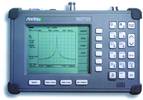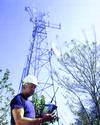
The trend toward field spectrum analysis is driven by the rapid expansion of wireless communications around the world. To keep up with the growing demand, many installations and system upgrades are underway, requiring on-site analysis and/or monitoring to optimise network performance.
To maintain existing systems, react to service interruptions and meet new rollout schedules, field engineers and technicians have to quickly determine whether they are dealing with a radio problem, a base-station problem or a transmission problem. Although portable spectrum analysers have been around for a few years, they are typically very heavy and usually difficult to manage and operate in a remote field environment.
Designed to satisfy the growing needs for field spectrum analysis, the new MS2711A handheld spectrum analyser from Anritsu takes a giant step toward the analyser of the future. Unlike traditional 'portable' spectrum analysers, the MS2711A weighs only 1,8 kg and features an easy-to-use, battery-operated design.
The MS2711A simplifies the job of locating, identifying, recording and solving communication systems problems quickly and easily, without sacrificing measurement accuracy. Operation of the instrument is straightforward and driven by firmware that simplifies the process of making measurements and interpreting the results. The menu-driven interface requires little training.
A full range of market capabilities such as peak, centre and delta functions are also provided, giving users a faster and more comprehensive measurement of displayed signals. Limit lines simplify amplitude measurements, give the capability to create quick, simple, pass/fail measurements. Frequency, span and amplitude functions are easily configured for optimum performance. Used together with the save set-up feature, these functions can help make testing easier and faster for less experienced users.
Precision calibration, synthesizer-based design and built-in measurement functions optimise accuracy and allow for easy verification of communication system compliance. Convenient operating procedures, high sensitivity and good repeatability pinpoint the smallest RF performance degradation early.

Applications
The most common spectrum analyser measurements are: modulation, distortion and noise.
Measuring the quality of the modulation is important for making sure your system is working properly and that the information is being transmitted correctly. Understanding the spectral content is important, especially in communications where the bandwidth is limited. The amount of power being transmitted (for example, to overcome channel impairments in wireless systems) is another key measurement in communications. Tests such as modulation degree, side-band amplitude, modulation quality and occupied bandwidth are examples of common modulation measurements.
In communications, measuring the distortion is critical for both the receiver and transmitter. Excessive harmonic distortion at the output of a transmitter can interfere with other adjacent communication bands. The pre-amplified stages in a receiver must be free of intermodulation distortion to prevent signal crosstalk. An example of this is the intermodulation of cellular carriers distorting other channels within the same cell. Common distortion measurements include intermodulation, harmonics and spurious emissions.
Noise is often the signal you want to measure. Any active circuit or device will generate noise. Tests such as noise figure and signal-to-noise ratio (although the MS2711A does not easily compute noise figure measurements) are important for characterising the performance of a device and/or its contribution to overall system noise.
Interference
With the increased deployment of wireless technologies, identifying the source of RF interference problems can be very difficult. The MS2711A solves this problem by providing the noise floor and phase noise performance necessary to enable the easy detection of signal interference. The unit's built-in AM/FM demodulation and zero span capability further facilities identification of signal interference.
With the unit's RS232 interface, a notebook computer can be used for automated control and collection of interference data in the field. A modem can also be used for remote operation.
Field strength
Using the field strength measurement feature can alert users when high external RF fields exist or when transmitters are not putting out their normal power levels. Additionally, the MS2711A can be used for site surveys and other signal mapping applications. In this application the MS2711A can optimise placement of antennas and access point in a WLAN or WPBX network. Identification of potential in-band interference as well as transmitted signal quality can be easily performed as the installer moves about the installation site.

On-site system testing
Precision calibration, synthesizer-based design and built-in functions enable the MS2711A to optimise accuracy and allow for easy verification of system compliance. Harmonic distortion, occupied bandwidth, antenna-to-antenna isolation and potential interference problems can be detected early.
Additionally, the MS2711A is ideal for field alignment of small dish antennas. Simply tune to the frequency of interest and monitor the received signal.

© Technews Publishing (Pty) Ltd | All Rights Reserved